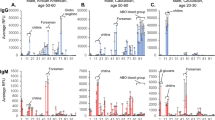Abstract
MICA antigens are polymorphic glycoproteins expressed on the surface of human endothelial cells and other cells. Antibodies against MICA have been found in transplant recipients and were found to be associated with decreased survival of kidney allografts. In the present work, we investigated the polymorphisms that are recognized by antibodies against MICA. Soluble MICA recombinant proteins representing 11 common alleles, two hybrid alleles, and two single amino acid mutated alleles were produced. Patterns of reactivity were determined with MICA bound to Luminex beads. In some studies, sera containing antibodies against MICA were absorbed by cell lines transfected with MICA*001, MICA*002, MICA*008, and MICA*009 or with untransfected cells, followed by testing of antibody reactivity against MICA proteins bound to beads. The monoclonal antibodies and sera used in this study were found to recognize up to 14 distinct MICA epitopes as demonstrated by their differential absorption/reactivity patterns. Among these, nine epitopes correlated with a single unique amino acid: one shared two signature amino acids, one shared three signature amino acids in close proximity, and three epitopes involved multiple amino acids in a nonlinear sequence. Two groups of public epitopes (MICA-G1 and MICA-G2) were characterized. MICA shared epitopes were determined by reactivity loss in single MICA antigen bead assays by absorption with MICA transfectants. Since these epitopes may be targets for antibody binding and possibly antibody-mediated allograft rejection, epitope identification may help understand the development of MICA antibodies and to identify suitable donors for sensitized transplant recipients.



Similar content being viewed by others
References
Bahram S, Bresnahan M, Geraghty DE, Spies T (1994) A second lineage of mammalian major histocompatibility complex class I genes. Proc Natl Acad Sci USA 91:6259–6263 doi:10.1073/pnas.91.14.6259
Hancock K, Narang S, Pattabhi S, Yushak ML, Khan A, Lin SC et al (2008) False positive reactivity of recombinant, diagnostic, glycoproteins produced in High Five insect cells: effect of glycosylation. J Immunol Methods 330:130–136 doi:10.1016/j.jim.2007.08.002
Robinson J, Waller MJ, Parham P, de Groot N, Bontrop R, Kennedy LJ et al (2003) IMGT/HLA and IMGT/MHC: sequence databases for the study of the major histocompatibility complex. Nucleic Acids Res 31:311–314 doi:10.1093/nar/gkg070
Vermehren D, Sumitran-Holgersson S (2002) Isolation of precursor endothelial cells from peripheral blood for donor-specific crossmatching before organ transplantation. Transplantation 74:1479–1486 doi:10.1097/00007890-200212150-00001
Zou Y, Mirbaha F, Lazaro A, Zhang Y, Lavingia B, Stastny P (2002) MICA is a target for complement-dependent cytotoxicity with mouse monoclonal antibodies and human alloantibodies. Hum Immunol 63:30–39 doi:10.1016/S0198-8859(01)00349-4
Zou Y, Bresnahan W, Taylor RT, Stastny P (2005) Effect of human cytomegalovirus on expression of MHC class I-related chains A. J Immunol 174:3098–3104
Zou Y, Han M, Wang Z, Stastny P (2006a) MICA allele-level typing by sequence-based typing with computerized assignment of polymorphic sites and short tandem repeats within the transmembrane region. Hum Immunol 67:145–151 doi:10.1016/j.humimm.2006.02.016
Zou Y, Heinemann FM, Grosse-Wilde H, Sireci G, Wang Z, Lavingia B et al (2006b) Detection of anti-MICA antibodies in patients awaiting kidney transplantation, during the post-transplant course, and in eluates from rejected kidney allografts by Luminex flow cytometry. Hum Immunol 67:230–237 doi:10.1016/j.humimm.2006.02.017
Zou Y, Stastny P, Susal C, Dohler B, Opelz G (2007) Antibodies against MICA antigens and kidney-transplant rejection. N Engl J Med 357:1293–1300 doi:10.1056/NEJMoa067160
Zwirner NW, Marcos CY, Mirbaha F, Zou Y, Stastny P (2000) Identification of MICA as a new polymorphic alloantigen recognized by antibodies in sera of organ transplant recipients. Hum Immunol 61:917–924 doi:10.1016/S0198-8859(00)00162-2
Author information
Authors and Affiliations
Corresponding author
Rights and permissions
About this article
Cite this article
Zou, Y., Qin, Z., Silveus, A. et al. Polymorphisms of MICA recognized by human alloantibodies. Immunogenetics 61, 91–100 (2009). https://doi.org/10.1007/s00251-008-0344-9
Received:
Accepted:
Published:
Issue Date:
DOI: https://doi.org/10.1007/s00251-008-0344-9




